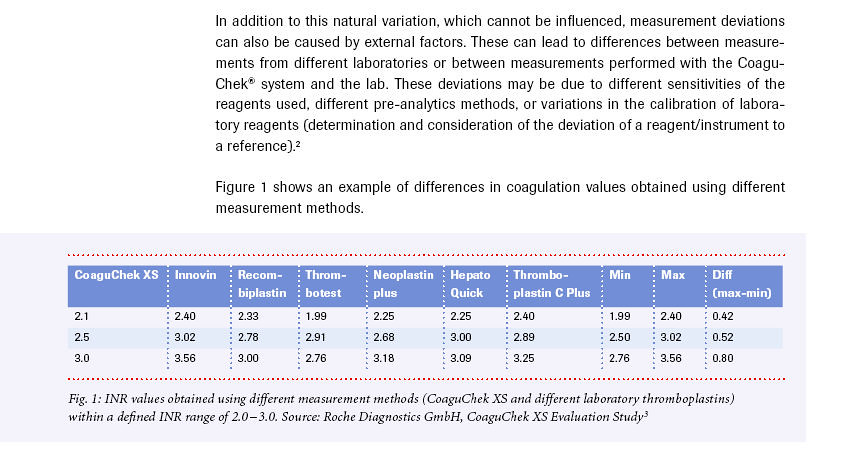I've been away from this forum for quite a few months - much longer than I should have. Every few months, I check out information about the various meters used for INR self-testing. Today I found that Roche has recalled MANY lots of the strips for the CoaguChek XS meter. This was an FDA mandated recall. Perhaps this was discussed already on this site. Perhaps not.
A few years ago, I did extensive testing of a much larger list of meters than are available today. I tested the Coaguchek S and Coaguchek XS and CoaguChek XS Pro, the Protime Classic and a newer model, InRatio and InRatio 2, and Coag-Sense meters. I checked them against each other, and used a lab test at a trusted medical facility or a hospital as a control.
In my testing, it became clear to me that the InRatio and CoaguChek XS often reported INR values that were higher than the lab - sometimes significantly higher. In 2013, I had a stroke because my InRatio meter showed that my INR was 2.6, when it was actually 1.7 (according to the hospital lab). This issue prompted my quest to find the most trustworthy meter.
Over the years, I detected an error in Protime strips. I reported it to the manufacturers of the Protime strips and they issued a recall and replaced the strips.
I was gratified to see that Alere discontinued the InRatio and InRatio 2 because of errors in reported INRs. I only wish they had done this a few years earlier.
In my testing, the CoaguChek XS sometimes reported a value near to that of my Coag-Sense meter, and similar to the hospital lab. In most cases, the results were higher (sometimes substantially higher) than either my Coag-Sense meter or the lab.
The Coag-Sense meter that I was testing often reported INR .1 or .2 below the lab results. In most cases, the prothrombin time was very close to (within 10%) the time reported by the lab. The only difference in INR seemed to be related to the value of the reagent used to compute the INR.
I felt (and still feel) that the consistency of the Coag-Sense in reporting the results is a strength. I believe that reporting an INR that is slightly lower than the lab results is a good thing -- I'd rather have a result that may require a slight increase in warfarin dose (and usually requires NO modification) than to have one that reports HIGHER than actual values. I feel that I'm at much higher risk when my INR drops below 2.0 than I am if it's above 3.5.
I don't work for Coag-Sense. I'm not in the business of supporting or promoting any particular meter or manufacturer.
In the light of the CoaguChek XS strip recall, I'm just suggesting that this should make Coag-Sense - still relatively unknown - worth considering if you're looking for a meter - or a replacement meter.
A few years ago, I did extensive testing of a much larger list of meters than are available today. I tested the Coaguchek S and Coaguchek XS and CoaguChek XS Pro, the Protime Classic and a newer model, InRatio and InRatio 2, and Coag-Sense meters. I checked them against each other, and used a lab test at a trusted medical facility or a hospital as a control.
In my testing, it became clear to me that the InRatio and CoaguChek XS often reported INR values that were higher than the lab - sometimes significantly higher. In 2013, I had a stroke because my InRatio meter showed that my INR was 2.6, when it was actually 1.7 (according to the hospital lab). This issue prompted my quest to find the most trustworthy meter.
Over the years, I detected an error in Protime strips. I reported it to the manufacturers of the Protime strips and they issued a recall and replaced the strips.
I was gratified to see that Alere discontinued the InRatio and InRatio 2 because of errors in reported INRs. I only wish they had done this a few years earlier.
In my testing, the CoaguChek XS sometimes reported a value near to that of my Coag-Sense meter, and similar to the hospital lab. In most cases, the results were higher (sometimes substantially higher) than either my Coag-Sense meter or the lab.
The Coag-Sense meter that I was testing often reported INR .1 or .2 below the lab results. In most cases, the prothrombin time was very close to (within 10%) the time reported by the lab. The only difference in INR seemed to be related to the value of the reagent used to compute the INR.
I felt (and still feel) that the consistency of the Coag-Sense in reporting the results is a strength. I believe that reporting an INR that is slightly lower than the lab results is a good thing -- I'd rather have a result that may require a slight increase in warfarin dose (and usually requires NO modification) than to have one that reports HIGHER than actual values. I feel that I'm at much higher risk when my INR drops below 2.0 than I am if it's above 3.5.
I don't work for Coag-Sense. I'm not in the business of supporting or promoting any particular meter or manufacturer.
In the light of the CoaguChek XS strip recall, I'm just suggesting that this should make Coag-Sense - still relatively unknown - worth considering if you're looking for a meter - or a replacement meter.

























